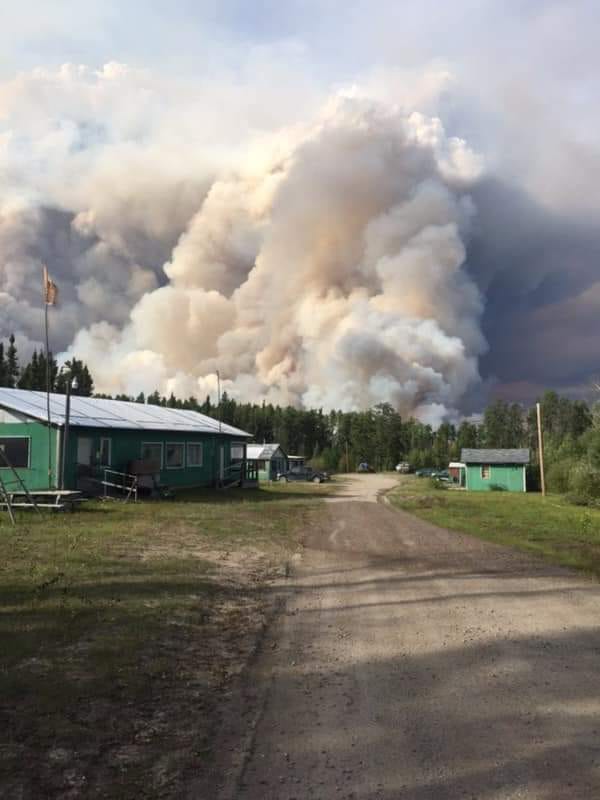
Valerie G. Barnes Connell Jordan
Daily Herald
On Sunday evening (Aug. 25), the Merkley fire, which had been burning for close to a month, is compromising the road, the sole access into the community of Southend, on the southern shores of Reindeer Lake. On the advice of the Saskatchewan Public Safety Agency (SPSA), and an emergency meeting of Chief and Council, the decision was made to evacuate the community of Southend.
At 6 a.m. Monday, Aug. 26, Duane Hiebert, Peter Ballantyne Cree Nation’s (PBCN) emergency management director, began arrangements to evacuate the community, beginning with P1 (those with breathing impacts) and P2 (those with heart impacts). They were able to get more than 700 people out by 11 a.m. when the sole road into the community had to be closed again.
Hiebert contacted the Lac La Ronge Indian Band (LLRIB) and Chief Tammy Cook-Searson sent four school buses. There were also three in the community used to get people out.
Evacuees were transferred to coaches down the road and were taken to Prince Albert, Saskatoon and Regina.
The evacuation continued in the evening and the last person was reported in Saskatoon at approximately 1 a.m. on Tuesday, Aug. 27.
Evacuees also left in private vehicles; some will stay with family and friends, Hiebert reported in his statement during a virtual media call on Thursday, Aug. 29.
Chief Peter Beatty thanked Hiebert, Chief Cook-Searson and the Canadian Red Cross and others for their work.
Some people also decided to stay in the Southend. They would be required to sign a waiver saying they were staying. Other may move out onto the lake to cabins and such, which is also a concern because of weather, particularly the waves and wind.
The fire remains out of control so there is no end in sight for the evacuation or the fire, Chief Beatty said in his statement on the media call.
Evacuees will be housed in hotels in the three cities.
“PAGC” (Prince Albert Grand Council) has been a great support in the community of Southend,” Hiebert said.
There are essential service people in the community looking after services such as public works and security.
Essential services folks will also continue to support the people remaining in the community, which is somewhat uncertain given the impact of the fire on the road into Southend, which is the only access road for the community. The road is compromised, so it may be “hard to provide that support,” such as groceries
Health services from other communities are also providing support and it will not end quickly, Hiebert said.
“This is just the beginning of this evacuation. It will probably last 10 days to 2 weeks … it may be required to burn out itself,” he said.
Meanwhile, the community of Sandy Bay remains evacuated, as the Flanagan fire is still out of control and impacting the community and the nearby Island Falls hydro power station.
A back burn was done earlier and some work on the station to keep in safe and operational, which moved the fire away from the station itself.
The Flanagan fire has doubled in size 17,418 ha to 34,707ha and the community of Sandy Bay, evacuated on Aug. 13, is still on evacuation, with no end in sight.
“All fires are not extinguished,” Beatty said. “They’re being assessed, monitored and managed.” Beatty said questions about the fires should be addressed to the provincial government.
He also said it’s possible the road, the sole access to Sandy Bay, may also be impacted by the fire.
He noted the change in fires in recent years.
“They’re burning hotter, the land is dryer,” he said.
The Merkley fire has been burning for around a month and is 101 sq. miles with not enough resources involved in fighting it, Beatty said.
The Flanagan is much bigger, two times the Merkley, at approximately 200 sq. miles.
“I don’t know why they’re letting it burn like that,” he said.
“We have hundreds of firefighters ready to be put on the fires. They’re not being deployed.”
If the aim is to extinguish wildfires, they would be put out when the fires are small, he said.
“This unnecessary policy to manage (wildfires) has to go,” he said, and if First Nations leaders were asked “their opinion, they would give a clear picture.”
Beatty said it would take three to five days of “steady rain,” to put the fire out, so people can come back home.
It depends on the weather, he said.
When asked about whether people’s livelihood would be impacted by the fires, he said, it would take years for the forest to rejuvenate, because conditions are dry.
Beatty referred to areas along the Hanson Lake Road, which there was replanting done in 1964, and it’s not all that big now.
“Traplines have been burn out and animals don’t come back quickly,” he said. “Many fur bearing animals are gone, even beaver and muskrat. Animals may move to a better area as well.”
Beatty also said, he didn’t know of any studies done on the impact of wildfires on water runoff and forest fires, but “I suspect there’s an impact on water life.”
So, “the berries are gone, animals are gone . It’s going to take years for the trees to come back. Unfortunately, this shouldn’t have happened,” Beatty added.
The good news is the Deschambault Lake evacuees, evacuated because of smoke and health concerns, have been able to go home. The Arm fire has been brought under control.
“Fires are not given enough resources to put it out, and not being given enough manpower to put it out,” Beatty said.
The PAGC health services said the air quality with so many wildfires “may not be good for healthy people,” Beatty said.

